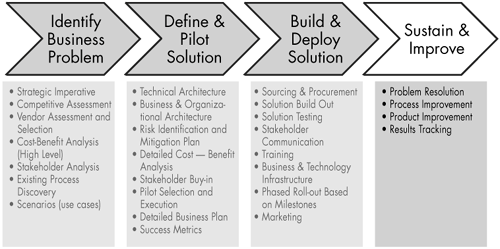| For many project teams involved in long and complex projects, a successful deployment may seem like the end of the project, but in reality, it is only the start of the project as far as external stakeholders, customers, and suppliers are concerned. Most of them are just beginning to experience the result of an RFID deployment, be it a new process, service, or product. At this stage, it is extremely critical to monitor and control the quality of the end-user or customer experience. The process or the solution should subsequently be optimized based on feedback.  Key factors to consider in this phase are as follows: Problem Resolution: A dedicated team with some ties back to the original project drivers should be assembled to answer any questions by internal or external stakeholders (customers included) and resolve any problems that might come up. Process Improvement: Various forms of data collected, including performance metrics, comments, complaints, and surveys, should be analyzed to find common themes. This should help identify which process is working well and which needs improvement. The resulting knowledge should be fed back into the internal system for further use in process improvement or new service or process development. Product Improvement: Just as in process improvement, the results, new advances in the field, and standards should be evaluated to see if a solution redesign is warranted. For example, after the successful outcome of RFID deployment to track containers in the second Gulf war (see the OEF/OIF case study in Appendix A), the DoD decided to roll out RFID to track its supplies at a more granular level. It is hoping to derive significantly more savings and efficiencies from this expanded effort and is making investments to make it a success. To make the process more robust, it is also focusing on standardized architectures and encouraging various standards bodies to converge on common RFID communications standards. The latter focus is expected to help the whole industry move toward a better set of architectures based on open standards. This latest DoD initiative is described in more detail Chapter 9, "Mandates as Business Catalysts." Results Tracking: The metrics collected from the process roll-out should be reviewed with the management and other stakeholders at specified times, per business plan. This exercise helps determine how actual results compare to projections. The analysis of this data could not only indicate how well the original business issue is being addressed, but it may also point to areas of improvement in planning and forecasting.
Typical questions to ask in this phase include the following: Are the expected results being achieved? If not, what is the root cause analysis? How is the quality being ensured in areas such as solution delivery and issue resolution? Are customers satisfied? How likely are they to recommend your company? Are various data points and metrics being fed back into the system for process improvement? Is there a practical process improvement or upgrade path in place to sustain the project in the future?
|
Avoid the following situations: |
The output of this stage is performance metrics as well as recommendations for improvement, which are fed back into the system for continuous improvement. |
